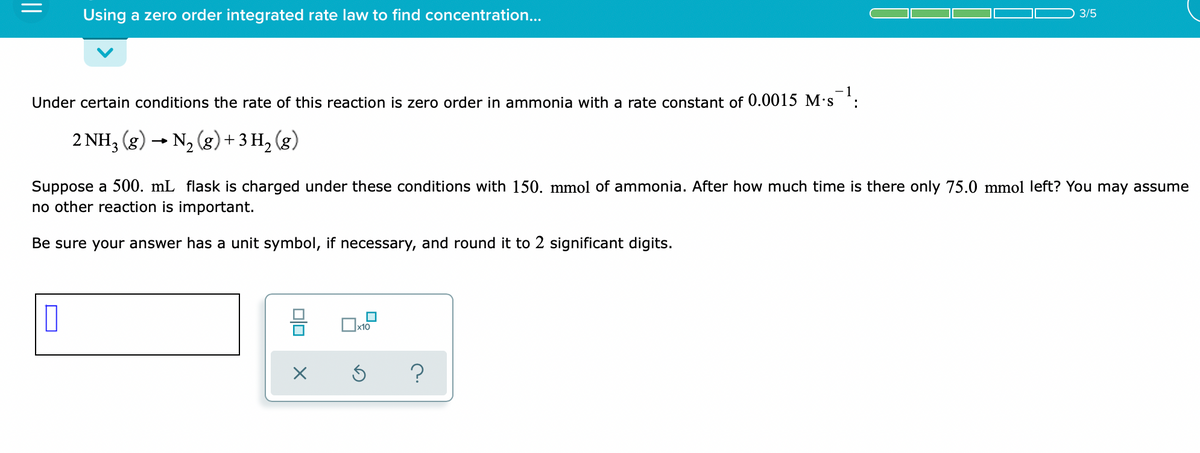Under certain conditions the rate of this reaction is zero order in ammonia with a rate constant of 0.0015 M•s '; 2 NH, (g) → N, (g) + 3 H, (g) Suppose a 500. mL flask is charged under these conditions with 150. mmol of ammonia. After how much time is there only 75.0 mmol left? You may assume no other reaction is important. Be sure your answer has a unit symbol, if necessary, and round it to 2 significant digits. ?
Under certain conditions the rate of this reaction is zero order in ammonia with a rate constant of 0.0015 M•s '; 2 NH, (g) → N, (g) + 3 H, (g) Suppose a 500. mL flask is charged under these conditions with 150. mmol of ammonia. After how much time is there only 75.0 mmol left? You may assume no other reaction is important. Be sure your answer has a unit symbol, if necessary, and round it to 2 significant digits. ?
Chemistry: An Atoms First Approach
2nd Edition
ISBN:9781305079243
Author:Steven S. Zumdahl, Susan A. Zumdahl
Publisher:Steven S. Zumdahl, Susan A. Zumdahl
Chapter11: Chemical Kinetics
Section: Chapter Questions
Problem 5RQ
Related questions
Question

Transcribed Image Text:Using a zero order integrated rate law to find concentration...
3/5
- 1
Under certain conditions the rate of this reaction is zero order in ammonia with a rate constant of 0.0015 M's
:
2 NH, (g) - N, (g) + 3 H, (g)
2 ΝΗ,
-N2 (g)+3 H, (g)
Suppose a 500. mL flask is charged under these conditions with 150. mmol of ammonia. After how much time is there only 75.0 mmol left? You may assume
no other reaction is important.
Be sure your answer has a unit symbol, if necessary, and round it to 2 significant digits.
x10
||
Expert Solution
Step 1
The given reaction is :
Rate constant = 0.0015 M.s-1
Volume of the flask = 500 mL
Number of millimoles of ammonia = 150 mmol
Trending now
This is a popular solution!
Step by step
Solved in 3 steps

Knowledge Booster
Learn more about
Need a deep-dive on the concept behind this application? Look no further. Learn more about this topic, chemistry and related others by exploring similar questions and additional content below.Recommended textbooks for you

Chemistry: An Atoms First Approach
Chemistry
ISBN:
9781305079243
Author:
Steven S. Zumdahl, Susan A. Zumdahl
Publisher:
Cengage Learning


Chemistry
Chemistry
ISBN:
9781305957404
Author:
Steven S. Zumdahl, Susan A. Zumdahl, Donald J. DeCoste
Publisher:
Cengage Learning

Chemistry: An Atoms First Approach
Chemistry
ISBN:
9781305079243
Author:
Steven S. Zumdahl, Susan A. Zumdahl
Publisher:
Cengage Learning


Chemistry
Chemistry
ISBN:
9781305957404
Author:
Steven S. Zumdahl, Susan A. Zumdahl, Donald J. DeCoste
Publisher:
Cengage Learning

Chemistry: The Molecular Science
Chemistry
ISBN:
9781285199047
Author:
John W. Moore, Conrad L. Stanitski
Publisher:
Cengage Learning

Chemistry & Chemical Reactivity
Chemistry
ISBN:
9781133949640
Author:
John C. Kotz, Paul M. Treichel, John Townsend, David Treichel
Publisher:
Cengage Learning

Chemistry: Principles and Reactions
Chemistry
ISBN:
9781305079373
Author:
William L. Masterton, Cecile N. Hurley
Publisher:
Cengage Learning